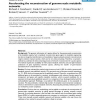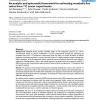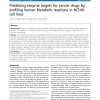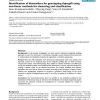NAR
2006
14 years 3 months ago
2006
The PUMA2 system (available at http://compbio.mcs. 10 anl.gov/puma2) is an interactive, integrated bioinformatics environment for high-throughput genetic sequence analysis and met...
BMCBI
2006
14 years 3 months ago
2006
Background: The genomic information of a species allows for the genome-scale reconstruction of its metabolic capacity. Such a metabolic reconstruction gives support to metabolic e...
BMCBI
2006
14 years 3 months ago
2006
Background: The availability of genome sequences for many organisms enabled the reconstruction of several genome-scale metabolic network models. Currently, significant efforts are...
BMCBI
2006
14 years 3 months ago
2006
Metabolic networks are naturally represented as directed hypergraphs in such a way that metabolites are nodes and enzyme-catalyzed reactions form (hyper)edges. The familiar operat...
BMCBI
2008
14 years 3 months ago
2008
Background: Metabolic fluxes provide invaluable insight on the integrated response of a cell to environmental stimuli or genetic modifications. Current computational methods for e...
BMCBI
2010
14 years 3 months ago
2010
Background: Drugs can influence the whole metabolic system by targeting enzymes which catalyze metabolic reactions. The existence of interactions between drugs and metabolic react...
BMCBI
2008
14 years 3 months ago
2008
Background: A logical model of the known metabolic processes in S. cerevisiae was constructed from iFF708, an existing Flux Balance Analysis (FBA) model, and augmented with inform...
BMCBI
2010
14 years 3 months ago
2010
Background: Microorganisms display vast diversity, and each one has its own set of genes, cell components and metabolic reactions. To assess their huge unexploited metabolic poten...
BMCBI
2008
14 years 3 months ago
2008
Background: In the present investigation, we have used an exhaustive metabolite profiling approach to search for biomarkers in recombinant Aspergillus nidulans (mutants that produ...
BMCBI
2008
14 years 3 months ago
2008
Background: Cellular metabolism is one of the most investigated system of biological interactions. While the topological nature of individual reactions and pathways in the network...





